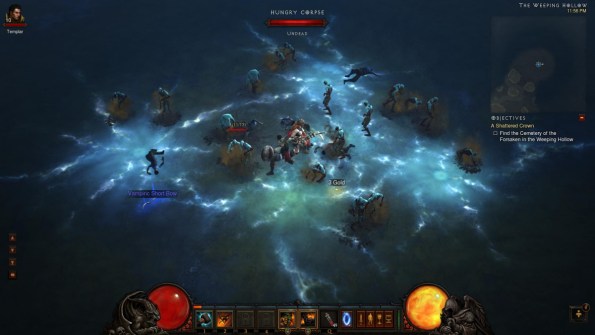Seeking Sanctuary: The Definitive Diablo III Preview
Story and Gameplay
Long-time fans of the series will recall Lachdanan, the heroic knight who resisted the evil that corrupted his comrades, even as Leoric's dying curse warped his body. There's no direct encounter with him -- Aidan released his soul back in Diablo I -- but you'll come across his journals in Diablo III and even see a ghostly echo of the murder of Leoric. Even the Mad King is as much to be pitied as scorned. Unlike his son, Leoric refused to serve Diablo, even as the Lord of Terror's whispering drove him mad.
His transformation from footnote to significant player is emblematic of the storytelling changes in Diablo III as compared to its predecessors. Blizzard wants Diablo III to tell a better, deeper story than Diablo II did. The good news, for those who prefer minimum encumbrance to their hack-and-slash, is that the details are optional. Lore entries are archived in the player's journal, and while they're worth a small amount of XP, players who don't know Lachdanan from a latte won't have to sweat the minor details.
So how's the gameplay?
In a word, fantastic. The game's mechanics have evolved considerably since Diablo II, and almost entirely for the better. Skills, for example, have been entirely redesigned. Unlike Diablo II, where skill points were invested and locked-in ever-after (until Patch 1.13), Diablo III's skills are entirely dynamic. Various attacks, AoE abilities, and passive skills become available as you level -- as do hotkey options. In the beginning of the game, you're confined to the two mouse buttons and a potion key; hotkeys 1-4 unlock as you gain experience. Players can have up to six skills available at any time.

Skills can be Active or Passive, with new passive skills unlocked every 10 levels
Unlike in previous games, you're free to switch your hotkeyed skills out in any combination, but there's a time delay before the new skills can be used. Unlike in Diablo II (post-Lord of Destruction), there's no fast switching between weapon sets; skill swaps are meant to provide this flexibility while the time delay prevents mindless min/maxing.
Skills are further modified by the use of runes. Runes also unlock as you level and change the function of a basic skill. The beginning Barbarian skill Bash, for example, normally knocks an opponent backwards. The first rune you gain, Clobber, changes the effect from a knockback to a chance to stun. Swapping runes also triggers a cooldown on the related skill. As in many games, certain endgame skills are on a timer and can only be used every few minutes. Skills and runes are linked -- you can't bind Bash+Clobber to one key and Bash+Onslaught to another.
The Hammer is her...erm. Nevermind.
All this talk of timers might leave some fans nervous that Diablo III eschewed D2's frantic gameplay, but in practice, that's not what happens. D3 puts a much greater emphasis on strategy than Diablo II did, but it does so in a way that caters to fast combat. Got a nasty group of Elites to tackle? Lead them down a corridor with a badly reinforced wall and drop it on them. Need a fast escape? If you're a Barbarian, you can use Leap to move between various levels in the dungeon, provided you lead the mobs to an appropriate spot.
Heading Backstage
Diablo III is poised to deliver all the slaughtery goodness of the original while simultaneously updating and expanding on D2's core gameplay.We've focused on the Barbarian in our screenshots, but we've spent time with all the classes and they're both distinctive and a lot of fun. Each feels different, and it's easy to see why Blizzard is talking up co-operative multiplayer--there's a lot of fun to be had in teaming up with others.
If all you wanted was a quick look at the game, we hope you've enjoyed this. If you want to know more about why we think Diablo III will be a great game, keep reading.










